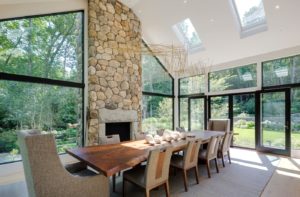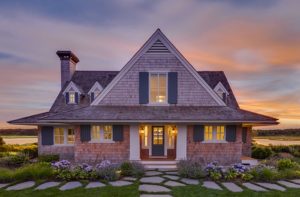New Kid on The Block
April 24, 2014
An established Boston suburb gets a fresh, new architectural neighbor that feels like an old friend.
Text by Kristine Kennedy Photography by Sam Gray
John MacDonald’s clients wanted something a bit different from the Tudors, colonials, and Shingle-style houses in their well-established Wellesley, Massachusetts, neighborhood. “They wanted something that spoke to who they are and would fit in but not be cookie cutter,” says the architect, principal at Morehouse MacDonald & Associates. “They didn’t want the same old, same old.”
The couple wanted their new home to be traditional and elegant, to be sure, but also distinctive. A clear picture came into MacDonald’s mind: a meandering Arts and Crafts–style house fit for contemporary life. While the time period for the Arts and Crafts movement paralleled the 1890 to 1920 construction dates of many Wellesley homes, the style is atypical for the area. “It’s more about the materials than the ornamentation, more of an artisan house,” says MacDonald.
Executed by builder Kevin Lagasse of The Lagasse Group, the house emphasizes hardy exterior materials, such as granite and stucco, with deep roof overhangs to provide sun and snow protection. “The house has a muscular feel to it,” says MacDonald.
The layout has public rooms running across the front of the house, with the living room and dining room flanking the front entry. The kitchen and family room run along the back of the house and face the yard.
The interior architecture has the same muscular presence, but in tall and slender form. Ceilings are ten feet high, and doorways are nearly ceiling height. An absence of doors in the public spaces facilitates easy flow. MacDonald incorporated plenty of millwork, but kept its design restrained. In the two-story foyer, the stairwell balustrade is thin, and wall panels give what the architect calls “a certain aristocracy and verticality.”
While the clients were fond of the Arts and Crafts idea, they wanted a twenty-first-century interpretation in the interiors. Los Angeles–based interior designer James Radin worked closely with MacDonald and Lagasse to tailor the home to the clients’ lives. “It’s a lively household,” says Radin. “The main thing is they’re young and wanted to do something fresh.”
Perhaps counterintuitively, Radin turned to Art Nouveau–period artist and architect Charles Rennie Mackintosh to inspire his own flowing forms, emphasis on materials over ornamentation, natural gray-on-gray palette, and comfortable utility. “I decided to look at it like we were doing something avant-garde at that time,” says Radin. “We wanted to make it look youthful, not stodgy, while making it luxurious.”
The foundation for all the rooms is a fumed-oak floor with a gray cast. Exposing wood to ammonium hydroxide fumes darkens it and brings out the wood grain for an almost cerused, textural look. As in many period houses, most of the walls are covered in paper and fabric, but Radin took a contemporary turn by using linens and grasscloths.
The designer’s administration of every variation of gray and neutral stands as a consistent element throughout the house. In the living room, the gray palette ranges from the gleam of the Christopher Spitzmiller ceramic lamps to the mouse gray of the cotton velvet curtains to the dark gray of the marble fireplace surround—the room’s dramatic focal point. Light gray fabric covers the walls. Lavender, in velvet pillows and armchairs, accents.
“The room is a push and pull between traditional and modern,” says Radin. While the curtains are of heavy velvet, they are pleated and hung in a contemporary way. A traditional rolled-arm sofa complements the streamlined style of the lavender chairs.
The purple accents get more emphasis in the dining room, which can be viewed from several doorways, motivating Radin to give it a jewel-box feel. “It’s kind of a dark, moody space; very evening looking,” he says. The push and pull of old and new is evident here, too. The suite of custom mahogany furniture in a high-gloss finish is reminiscent of 1920s furniture, and the velvet chair fabric is edged in gimp. The chandelier and sconces are crystal, but a contemporary interpretation. And as was common in old-fashioned rooms, there is a patterned rug, but this one is a David Hicks–style geometric.
For the family room, Radin shifted his palette to beigy neutrals. “That room is much more casual,” he says. In contrast to the dramatic fireplace in the living room, this two-way fireplace is surrounded in antique limestone with a rough hand. Soft and fluffy was Radin’s mantra for the upholstery fabrics, like the tactile chenille that covers the sofa. Extra-large nailheads on the pair of chairs opposite, as well as the ottoman’s tufting, add more texture. The color of the ottoman and the stained wood of the fireplace armchairs add warmth. For his part, MacDonald made the room more intimate by designing a coffered ceiling to take about six inches off the ceiling height.
The kitchen has plenty of seating: a pair of Stickley-style chairs near the fireplace, the banquette, and the island seating. On the working side of the kitchen, casual gray limestone countertops contrast with the sparkly glass backsplash and high-gloss, bright white cabinets. Radin describes the cabinets as a cross between modern and traditional, while light fixtures and faucets are a contemporized version of an old-fashioned look.
The final result is a home that is distinctly the clients’. Radin says that while the architecture is appropriate for Wellesley, it’s unusual enough that you wonder what the house is all about. And the moment the front door opens, it’s clear this home has a personality all its own. •
Architecture: Morehouse MacDonald & Associates
Interior design: James Radin Interior Design
Builder: The Lagasse Group
Landscape design: Gregory Lombardi Design
Share
![NEH-Logo_Black[1] NEH-Logo_Black[1]](https://www.nehomemag.com/wp-content/uploads/2022/08/NEH-Logo_Black1-300x162.jpg)


















You must be logged in to post a comment.